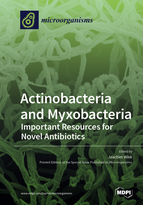Actinobacteria and Myxobacteria—Important Resources for Novel Antibiotics
A special issue of Microorganisms (ISSN 2076-2607). This special issue belongs to the section "Microbial Biotechnology".
Deadline for manuscript submissions: closed (30 April 2018) | Viewed by 42799
Special Issue Editor
Interests: polyphasic taxonomy; cultivation methods; isolation methods; taxonomy and secondary metabolites from Actinobacteria and Myxobacteria; morphology and fine structure of Actinobacteria and Myxobacteria
Special Issues, Collections and Topics in MDPI journals
Special Issue Information
Dear Colleagues,
Bacterial infections cause millions of deaths globally, particularly in children and the elderly, and four of the 10 leading causes of death are infectious diseases in low- and middle-income countries. The continuous use of antibiotics has resulted in multi-resistant bacterial strains all over the world, such as Community-associated Methicillin-resistant Staphylococcus aureus (MRSA), extended-spectrum β-lactamases (ESBLs), and, as expected, hospitals have become breeding grounds for human-associated microorganisms, especially in critical care units.
Natural products are the bedrock and a valuable source for drug discovery programs. More than 60% of the drugs that are available on the market are derived from natural sources. Many antibiotics are made chemically via modification of natural products through a process called semi synthesis. Natural product structures have the characteristics of a high chemical diversity, biochemical specificity, and high binding affinities to their specific receptor and also interact with a wide variety of biological targets.
Microorganisms produce a wide range of natural products, which are used as lead components in the drug discovery era. Over 6000 compounds of microbial origin with anti-microbial activities have been isolated. The microbial world represents 90% of all biological diversity and less than 1% has presently been explored (Molinari 2009). Mining microbial diversity is the key to obtaining high compound diversity, because a very large source for new natural products remains unexplored. To date, a few groups of microorganisms have been known to be high and potent producers of natural products: Actinomycetes, Bacillus, cyanobacteria, fungi and myxobacteria.
Dr. Joachim Wink
Guest Editor
Manuscript Submission Information
Manuscripts should be submitted online at www.mdpi.com by registering and logging in to this website. Once you are registered, click here to go to the submission form. Manuscripts can be submitted until the deadline. All submissions that pass pre-check are peer-reviewed. Accepted papers will be published continuously in the journal (as soon as accepted) and will be listed together on the special issue website. Research articles, review articles as well as short communications are invited. For planned papers, a title and short abstract (about 100 words) can be sent to the Editorial Office for announcement on this website.
Submitted manuscripts should not have been published previously, nor be under consideration for publication elsewhere (except conference proceedings papers). All manuscripts are thoroughly refereed through a single-blind peer-review process. A guide for authors and other relevant information for submission of manuscripts is available on the Instructions for Authors page. Microorganisms is an international peer-reviewed open access monthly journal published by MDPI.
Please visit the Instructions for Authors page before submitting a manuscript. The Article Processing Charge (APC) for publication in this open access journal is 2700 CHF (Swiss Francs). Submitted papers should be well formatted and use good English. Authors may use MDPI's English editing service prior to publication or during author revisions.
Keywords
- Polyphasic Taxonomy
- Secondary Metabolites
- Biotechnology
- Differentiation
- Biosynthesis
- Morphology
- PKS and NRPS







